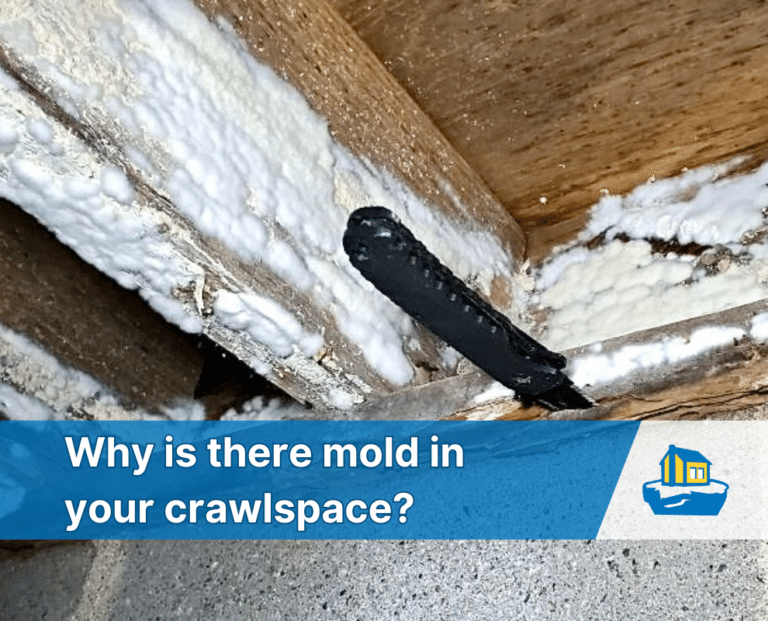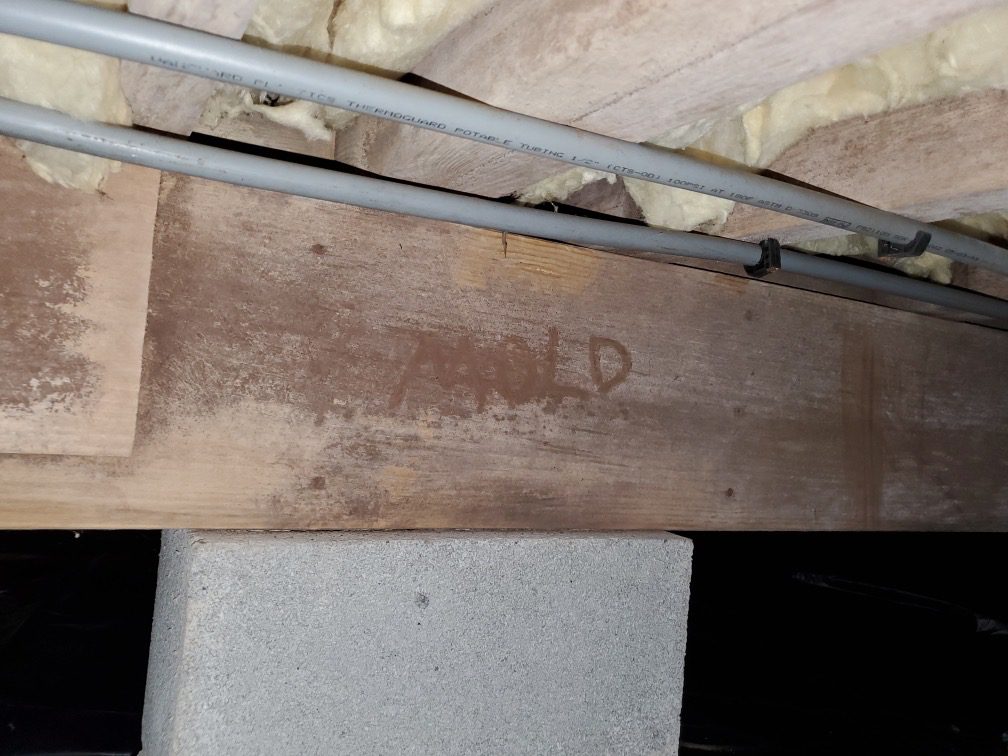4.8 1700+ Google Reviews

Crawlspaces are the dark, cavernous foundations of our homes. Although most homeowners refuse to spelunk through them, regular crawlspace inspections and maintenance are crucial to your home’s overall health. Sadly, most crawlspaces get neglected, resulting in expensive repairs. Perhaps the most significant concern with crawlspaces is mold growth. If you’re a homeowner, you’ll want to understand why there is mold in your crawl space and what to do about it.
A little mold is normal and, generally, nothing to be concerned about. However, a mold infestation poses problems for your house as well as health risks.
Molds are microscopic organisms from the Fungi kingdom. There are over 100,000 known types of mold, and they are always present all around us.
Interestingly, there is no such thing as black mold, white mold, or yellow mold. Many different types of mold are black, white, yellow, and all colors.
If mold is always present all around us, why is it bad for our homes?
Mold digests dead organic matter making them vital to our environment. However, our homes have many organic materials making them a great food source for mold.
Luckily, molds need water, organic material, and the right temperature to thrive. When mold spores land on a surface, they look for moisture and food. Once found, they begin to break down the material and reproduce. A single mold can release thousands of mold spores, making a mold problem spread quickly.
For the most part, our homes are dry and not suitable for mold. However, plumbing leaks, roof leaks, and other excess moisture encourage mold growth.
Contrary to animals, molds break down their food before digesting it. To do so, they excrete enzymes to break down the material and then absorb the nutrients. So, if you have a mold issue in your wall or in your crawl space, the mold is rotting the wood to absorb its nutrients.
Obviously, this causes structural damage.
Mold is a type of fungus, and mildew is a type of mold or fungus. Although there are biological differences, it is not important for a homeowner to distinguish between them. They all grow when there is excessive moisture and damage our homes.
Regardless of the specific type, the moisture needs to be addressed, the growth remediated, and the damage assessed and repaired if needed.
We know that mold needs moisture and organic material to thrive. So, why is there mold in your crawlspace? The simple answer to why there is mold in your crawl space is that there is excessive moisture in your crawl space. A crawlspace moisture problem creates the perfect environment for mold to thrive.
With this in mind, many homeowners wonder the moisture is coming from. The moisture in our crawlspaces comes from three primary sources – the ground, outside, and mechanical systems.
If you remember from middle school science class, water has a continuous cycle. Water evaporates from water sources and is taken higher in the atmosphere by air currents. Then, in the cooler upper atmosphere, water condenses into clouds. Next, water comes back down to earth through precipitation. Finally, after returning to the ground and bodies of water, it evaporates, starting the cycle over.
The evaporating groundwater is the water vapor relevant to our crawlspaces. Water vapor molecules moving through the dirt floor, making their way back to the atmosphere, can concentrate and condense in our crawlspace. This water causes mold growth in your crawl space.
To combat this, building codes require crawlspace ventilation to drive water vapor outside. In addition, a class 1 vapor retarder may be required.
Vapor barriers are materials that do not allow water vapor to permeate through. The most common crawlspace vapor barrier is plastic sheeting installed over the dirt floor.
Humidity, or rather relative humidity, is the amount of water in the air, in the form of vapor, compared to how much water it can hold. Hot air can hold more moisture than cold air.
Humidity and temperature always move from areas of higher levels to lower levels. For example, for two adjacent spaces, where one space is hotter than the other, the hot air will move into the colder space until both are at the same temperature. The same is true for humidity.
So, hot, humid outdoor air naturally pushes into cool crawlspaces through crawlspace vents. The crawl space vents that vent ground water vapor bring in water vapor from the outside air.
In addition, to humidity, outside moisture also includes rain and snow. Ideally, your foundation walls were designed to keep water out. However, over time, cracks and other deficiencies develop that allow water into the crawlspace.
For example, homes with no gutters subject the foundation walls to significant amounts of water. Over time, this can damage the foundation walls and allow water to leak in.
The final source of crawlspace moisture is mechanical sources. Leaky pipes and HVAC systems, as well as damaged or open vents, will increase moisture levels in the crawlspace. Damaged dryer vents are particularly problematic as dryers exhaust a significant amount of warm moist air.
Warm moist air condenses into water droplets and causes mold in your crawl space.

Mold spores that land on floor joists with high moisture content will stay, absorb the nutrients from the wood, and reproduce. Remember that mold spores release enzymes to rot the wood and absorb the nutrients.
Plus, the wet wood also attracts termites and other wood-destroying insects.
Our focus and expertise are on the causes and effects of mold on wooden structures. Our understanding is that the health problems associated with mold are not well understood. The CDC says :
“Exposure to damp and moldy environments may cause a variety of health effects or none at all. Some people are sensitive to mold. For these people, exposure to molds can lead to symptoms such as stuffy nose, wheezing, red or itchy eyes, or skin. Some people, such as those with allergies to molds or with asthma, may have more intense reactions.
In 2004 the Institute of Medicine (IOM) found there was sufficient evidence to link indoor exposure to mold with upper respiratory tract symptoms, cough, and wheezing in otherwise healthy people; with asthma symptoms in people with asthma, and with hypersensitivity pneumonitis in individuals susceptible to that immune-mediated condition.”

The best way to prevent a moldy crawlspace is crawl space encapsulation. Crawlspace encapsulation involves sealing the floor with a class 1 vapor retarder, sealing and insulating the crawl space walls, and dehumidifying the crawlspace air.
Alternatively, you can try to install a vapor barrier and keep the crawlspace vents closed. However, this method is not always effective.
A holistic approach is required when dealing with crawlspace mold. The first step in dealing with a moldy crawl space is determining the source of the moisture. Inspect your crawlspace for leaking water pipes, standing water, efflorescence, lint, and broken ducts.
Any source of moisture will need to be dealt with. Unfortunately, this is not always a straightforward process. For example, rising groundwater in the crawlspace needs a sump pump. On the other hand, moisture from outside humidity requires crawl space encapsulation. In some situations, you may need multiple solutions to address multiple sources of moisture.
Once the source of moisture is identified, you can plan for mold remediation. A common misconception is that the mold can be sprayed with bleach or other chemicals to kill it.
However, spraying anything on mold often makes the problem worse. Bleach is 90 percent water, and mold needs water to survive. After bleach is sprayed on the wood, the bleach evaporates fairly quickly. Then, the water absorbs into the wood. Although the bleach may kill wood on the surface, the mold’s roots are deep in the wood. The lingering water and remaining roots allow the mold to blossom again.
This is why mold problems often get worse a few days after bleach application.
Proper remediation requires abrasive measures to remove mold and its roots. Unfortunately, this releases many mold spores affecting your home’s indoor air quality. This is why mold infestations should be handled by a professional mold remediation company. The best mold companies use powerful fans with HEPA filters to limit the spread of mold spores.
After the moisture and mold are addressed, you’ll need to inspect your crawl space for damage. Moisture and mold result in wood rot and attract termites. Gear up with a flashlight and probe. Visually inspect, and probe for soft wood. In addition, look for signs of termites.
Ideally, you would check the humidity levels and use a moisture meter to check the wood moisture levels.
Mold needs moisture and organic material to thrive. Crawlspaces have plenty of organic material, so if you have mold in your crawlspace, you have a moisture problem. The primary sources of moisture in a crawlspace are water vapor from the ground and humidity from outside.
Check your crawl space regularly for signs of mold. If you have a mold problem, then you have a moisture problem. The best thing to do is call a mold specialist.